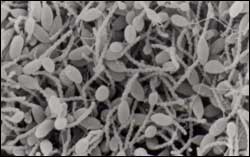Bacteria feed on smelly breath (and feet)

Hyphomicrobium sulfonivorans
Researchers have isolated bacteria which can grow on and ‘mop up’ smelly compounds in the mouth that are linked to bad breath. These smelly, highly reactive ‘one-carbon’ compounds are naturally produced from the breakdown of sulphur-containing amino acids in the mouth.
Dr Ann Wood and her colleagues at Kings College, London, reported these findings in the August issue of Environmental Microbiology. The odour-eating methylotrophic bacteria were isolated from the tongue, tooth plaques (supra-gingival plaques) and gum edge (sub-gingival plaques) of volunteers. They include strains of Bacillus, Brevibacterium casei, Hyphomicrobium sulfonivorans1, Methylobacterium, Micrococcus luteus and Variovorax paradoxus.
The composition and function of bacterial flora of the mouth have been extensively studied in the past, but until now it was not recognised that methylotrophic bacteria are part of the normal oral microbial environment or ‘microflora’.
The researchers found no difference between strains of bacteria found in the mouths of healthy volunteers and those suffering from progressive gum disease (periodontitis), a condition which is often associated with smelly breath. However, no assessment was made of the levels of methylotrophic bacteria present, low levels of which may be associated with bad breath.
In a previous paper, Dr Wood et al found that the foot is also a source of methylated sulphides and strains of these odour eating bacteria, including Brevibacterium and Methylobacterium, which are also part of the normal foot microbial flora.
The results of this study will assist future investigation into the detection of the levels of methylotrophic bacteria and their possible relationship with the oral concentrations of methylated sulphides. This may lead to a natural way of reducing smelly breath and feet.
Media Contact
More Information:
http://www.blackwell-synergy.com/toc/emi/7/8All latest news from the category: Life Sciences and Chemistry
Articles and reports from the Life Sciences and chemistry area deal with applied and basic research into modern biology, chemistry and human medicine.
Valuable information can be found on a range of life sciences fields including bacteriology, biochemistry, bionics, bioinformatics, biophysics, biotechnology, genetics, geobotany, human biology, marine biology, microbiology, molecular biology, cellular biology, zoology, bioinorganic chemistry, microchemistry and environmental chemistry.
Newest articles

A universal framework for spatial biology
SpatialData is a freely accessible tool to unify and integrate data from different omics technologies accounting for spatial information, which can provide holistic insights into health and disease. Biological processes…

How complex biological processes arise
A $20 million grant from the U.S. National Science Foundation (NSF) will support the establishment and operation of the National Synthesis Center for Emergence in the Molecular and Cellular Sciences (NCEMS) at…

Airborne single-photon lidar system achieves high-resolution 3D imaging
Compact, low-power system opens doors for photon-efficient drone and satellite-based environmental monitoring and mapping. Researchers have developed a compact and lightweight single-photon airborne lidar system that can acquire high-resolution 3D…





















